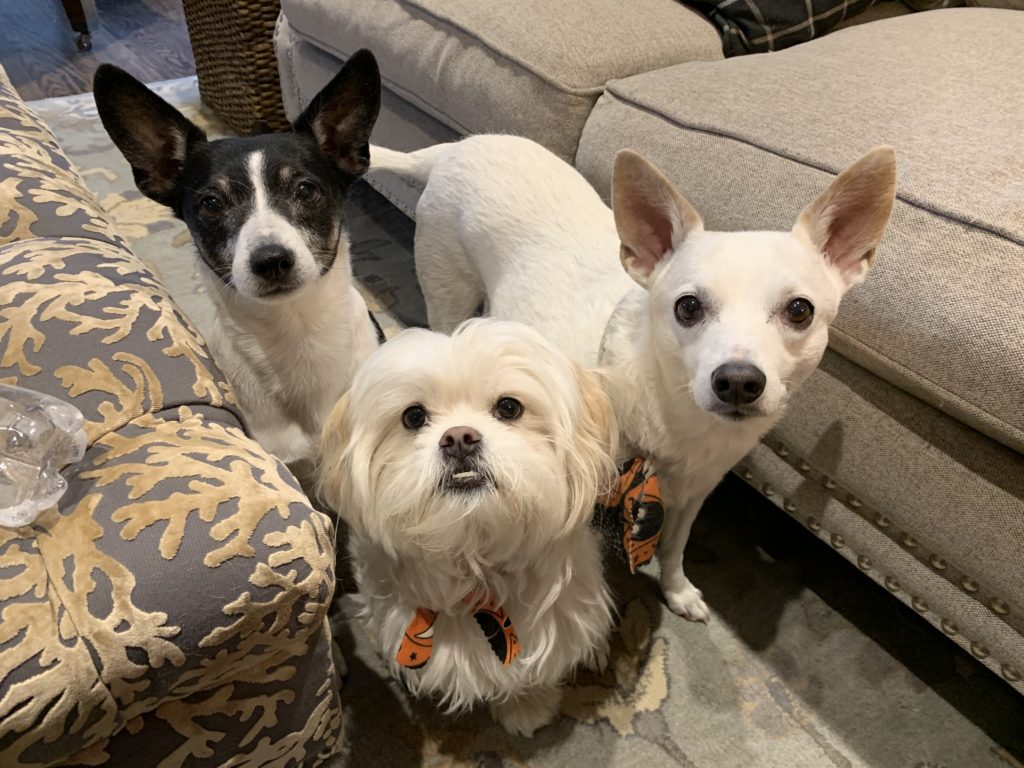Teaching 3 Dogs to Stay Calm While Getting Leashed Up
By: David Codr
Published Date: November 18, 2019
For this Omaha dog training session we worked with 3 very excitable and barky dogs; Brody, Riley aka Baby and Gabby (from left) – teaching them to stay calm when being leashed up.
One of the things I asked the guardians to do is consider the dogs to be a collective whole instead of “my dog,” your dog,” etc. Many people are unaware that dogs are more aware of how we see and perceive them. Saying its your dog in a dismissive way, that you dislike a dog or find some of its characteristics annoying are not words the dogs will understand. But the body language the human gives off when saying these things will be understood.
Studies have shown dogs can pick up on anxiety, fear, frustration, happiness, annoyance or other emotions from humans. This can have a positive or negative impact on the dog. This is why I spend so much time as Omaha’s Dog Behavior expert teaching people about dog body language and dog psychology. I look for positive words vs negative or even seemingly benign labels; guardian instead of owner, determined instead of stubborn, confused instead of bad, etc.
Many humans mistakenly think their dog knows or understands things that we haven’t taken the time to teach them. A classic example of this is potty training. People take a puppy out when it needed to potty anyway. The human says “go potty” and the puppy does as that was its intention the whole time. But we see that as “understanding” what we said. Then the next time we go out and give the command and the dog doesn’t potty? We see the puppy as being “naughty.” Instead we need to teach and train the dog to go potty how we want like I do in this video.
We covered a number of dog behavior tips and suggestions like petting with a purpose and passive training – which in this house are probably going to be the easiest and most effective things to do. Enforcing rules is also super important, but it will require everyone to do so. In some capacities, we can do things like using X Mats to keep the dogs off the furniture, but everyone being on the same page will dramatically increase the progress.
One of the dog behavior problems we were called in to fix was to stop the dogs from getting so excited when being leashed up. This is a prime example of Classical Conditioning – every time the human walks to where the leashes are and picks them up, something fun for the dogs happens afterwords. With enough repetition, the dogs start to get over excited when they recognize what is happening.
The free positive dog training video below covers how to teach dogs to stay calm when being put on the leash.
One of the tricks to keeping dogs from getting too excited when you leash them up is to practice the exercise as detailed above, but at times when you are not planning on taking the dog out for a walk. With enough practice, the dog sees it as a drill and learns the behavior expected for each step of the leashing up process is to stay calm when the leashes come out.
Training dogs to stay calm when being leashed up isn’t hard, you don’t have to be a professional Rat Terrier dog trainer, it just takes practice. Id like to see the guardians practice this exercise a few times daily and absolutely a few times before actually going for a walk.
Another issue the humans wanted help with was teaching the dogs to behave and not escape when people come to the door. I promised the guardians I would include a link to a positive dog training video that details how to teach a dog to move away from the door when someone knocks or rings the doorbell. This is another exercise that needs to be practiced before used when its “real.” All of these exercises will be learned the easiest by practicing the each dog separately.
To help the family remember all the tips we shared in this at home Nebraska dog training session, we recorded a roadmap to success video.
Categorized in: Dog Behavior


